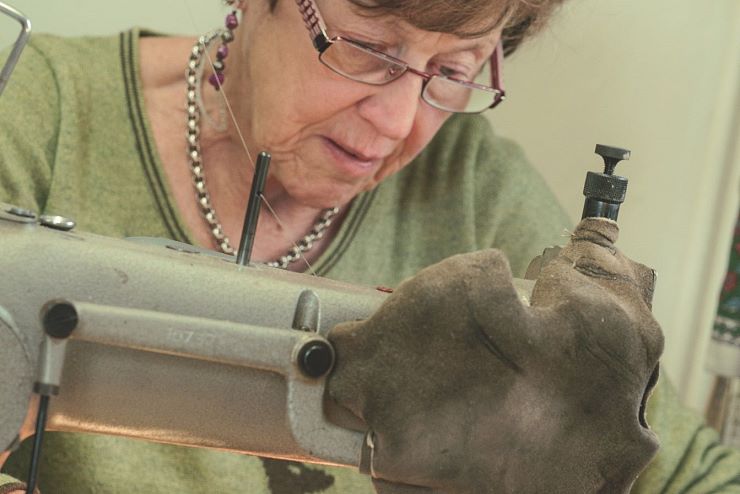Säcklerei Gruber-Leitner Kufstein
Always practical, always fashionable, simply perfect: Lederhosen
In the area around Kufstein you can buy your lederhosen from an authentic lederhosen maker, or have old ones repaired/renewed. Consider yourself very lucky, as the craftsmanship that generations of the Gruber-Leitner family has dedicated themselves to is becoming increasingly rare. The family operation is now one of the last of its type in Tyrol.
The roots of this now rare craft reach back to the 15th or 16th century. At that time, leather sacks were produced for transporting coal. That’s where the term “Säcklerei” (sack-maker) came from. People soon realised that the robustness of leather meant it was also perfect for making clothing. After its introduction as an item of work clothing, lederhosen (leather trousers) soon developed into a fashion trend.
The history of the Gruber-Leitner family business starts in 1832. Initially a company that made gloves, it has been making lederhosen since 1897. These days there is no school that teaches the art of lederhosen production. The only way to learn is being taught by a master. In Kufstein, Christian Leitner continues the business with Johanna Moser and his mother Elvira Leitner. He also runs a photo studio, but says it would be a pity if this traditional business and all its leatherwork knowledge were to die out.
Lederhosen from the region
One thing is certain: The deerskin trousers are as popular as ever. Hand embroidered leather from the region is particularly valuable. Christian Leitner receives most of his leather from Tyrol and Bavaria, or sometimes from Pongau near Salzburg. The only parts that come from further away are the buttons. “These are made from tagua nut or ‘vegetable ivory’ as this is more resilient than plastic buttons and cheaper than staghorn buttons,” explains the expert. Naturally it’s ultimately up to the customer which buttons they would prefer.
A constant over time
The business doesn’t experience any particular trends or slack periods. The demand remains constant and stable. Lederhosen colour usually doesn’t play a big role. “Though in recent years we’ve noticed that customers prefer that the leather doesn’t have a uniform colour,” explains the lederhosen maker. “The splotchier the trousers are, the older and more natural they look.” Sometimes the traditional workshop receives very old lederhosen. Generally they’re heirlooms that are being reworked for sons or grandsons. “It is painstaking work,” explains Elvira Leitner. In general, the individual parts of lederhosen are embroidered before her son Christian sews them together. The leather is easier to hold and guide in individual pieces. To embroider lederhosen that are already sewn together is much more difficult.
Preferences and origin are decisive
Tyrolean lederhosen have a flat seam on the seat. In Salzburg men prefer a seam that rises in an arch on the seat (a “tellernaht” or plate seam). Christian Leitner is flexible when it comes to these decisions. In the end it’s the customer who decides what they like and want. The same applies for the embroidery and the thread colour. The patterns, on the other hand, are another matter. Associations such as the Kufstein Stadtmusikkapelle (city band) or the Thierberg Schützen (gun club) have their own patterns, and Elvira Leitner will only embroider these on the trousers of actual members. Private customers are given a book of embroidery patterns that shows a selection of around fifty different options. Using feathers of local geese, Christian transfers the patterns onto the leather pieces with gum arabic and then sticks the pieces of leather together with rye flour glue. Then it’s his mother’s turn with the needle. She embroiders the deer leather with silk threads. Then the pieces are sewn together using a machine. Finally the lederhosen are finished. It takes up to 35 hours of work to make a single pair of short lederhosen. Knee-length trousers are less decorative and therefore less time-consuming to make. Goat and cow leather is also sometimes used. These two materials are embroidered using a machine, only deer leather is hand embroidered.
Lederhosen are practically always in fashion
The style of lederhosen in recent years has changed a bit, but that doesn’t mean that older ones look old-fashioned. The only difference is that the waistband now ends around three finger widths under the belly button, not over it as was the case in the past. There aren’t many rules when it comes to wearing lederhosen. “The only thing is that if a man wears lederhosen to his own wedding, they must be knee length. His guests can wear shorter ones though,” says Christian Leitner. Lederhosen mean that you’re always festively and fashionably dressed. That’s why we hope that this lederhosen workshop in Kufstein stays open for a long time.
Look over their shoulders
Opening hours:
- Monday - Friday from 9:00 am - 12:00 noon and 3:00 - 5:00 pm
- Saturday from 9:00 am - 12:00 noon
- Wednesday afternoon closed





